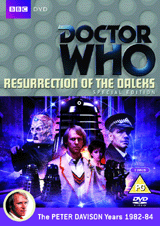 The Doctor, Tegan and Turlough arrive in 1980s London, finding themselves embroiled in a plot involving some old villains and a couple of guest stars from the world of light entertainment.
The Doctor, Tegan and Turlough arrive in 1980s London, finding themselves embroiled in a plot involving some old villains and a couple of guest stars from the world of light entertainment.
What’s apparent from the start of 1984’s ‘Resurrection Of The Daleks’ is that, although it feels like fairly standard Peter Davison-era Doctor Who, mostly it comes across as if Eric Saward wrote to the BBC really wanting to get involved with that sci-fi show Terry Nation worked on and was then somewhat startled to discover that it wasn’t Blake’s Seven. It’s all here: grim-faced mercenaries, disaffected crew members, an unrelenting body count.
Since one of the many extras included in this expanded set is best described as a love letter to Saward as being the only one who really ‘got’ Doctor Who at the time, it’s instructive to note that one of the most successful stories of the Fifth Doctor’s tenure is one that pushes the form of what to expect from a Doctor Who story.
What’s striking is that the two biggest audience draws for this episode – the Doctor and the Daleks – are largely irrelevant: most of the story concentrates on those aforementioned mercenaries and crew members. Far from being a negative, this is all to the good, since it’s essentially a fresh take on a very well worn track. Usually, the Doctor and pals turn up to find a small rag-tag group of victims being worn down by the villains of the piece. Here, however, we get to see the story from the point of view of the guest stars, in which a strange visitor and his companions pop in to save the day. It’s the sort of plotting device that would become more common after 2005 and ensures that any death on screen actually means something. And there are a great many deaths. Not even Rula Lenska’s safe.
‘Resurrection Of The Daleks’ is not an ideal production, however. While the location filming in Wapping looks wonderful, much of the production feels perfunctory. The Daleks are presented without fanfare, majesty or indeed a fresh lick of paint – it’s as if they’ve been pulled straight off the Longleat exhibition. Even Davros is introduced almost by accident, glowering behind a sheet of frosted plastic, unremarked upon for a healthy chunk of screentime before anybody thinks to acknowledge his presence.
It’s almost as if the production team had already decided that it was a done deal that he would appear in every Dalek story for the rest of the classics and therefore needed no smoke and mirrors to delay the reveal of his presence. Meanwhile, though characters like Lytton are full of charisma (thanks to Maurice Colbourne’s un-showy performance), there’s not a lot of effort to give the supporting characters, well, character.
It’s also not a great story to serve as Janet Fielding’s swansong. Tegan, potentially one of the sparkiest and feistiest companions in the classic series, is reduced to being concussed and talking about tea for much of the narrative. Quite why she couldn’t have – in what is her last adventure, after all – swapped places with Turlough and exercised her ‘brave heart’ with Rula Lenska isn’t something that’s explained in the DVD extras.
Something that is discussed at great length amongst the extras is the opposite directions the show was being pulled in the early 1980s – the general opinion being that producer John Nathan Turner may have been a great showman and publicist, but that he didn’t really understand Doctor Who – and that the show was exhausted by concepts such as three or more companions in the TARDIS (although when asked if the crew was too large for writers to think of decent stories, it’s clear that Steven Moffat, while striving to be diplomatic, would relish the challenge).
In short, there are a few too many irritants in this story: the un-Dalek like dialogue given to the Daleks, for instance, and the sense that the pepper-pots have been wheeled in simply to spike ratings. But this doesn’t stop ‘Resurrection Of The Daleks’ being a rattling good story, even at odds with itself – The Doctor doesn’t even meet many of the major characters, for instance – and there can perhaps even be (if you want to read such things into the story) an early hint at the Dalek/Time Lord ‘Time War’ that formed the backbone of the show’s comeback in 2005, although it’s anyone’s guess why the Daleks would want to send the Doctor to assassinate the President of the Time Lords.
There’s also a bit of genuine time travel in watching a Doctor Who story set in a close to contemporary setting (the Docklands in London) in a Docklands that is now almost entirely demolished into history. Not the best Dalek story, then, but quite far from the worst: full of drive, energy, and quite genuinely never a dull moment.
![]()
Released on DVD on Monday 28th March 2011 by 2entertain.

